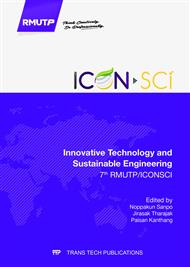[1]
A. Thuault, E. Savary, J. Moreau, M. Descamps, S. Marinel and A. Leriche, Improvement of the Hydroxyapatite Mechanical Properties by Direct Microwave Sintering in Single Mode Cavity, Journal of the European Ceramic Society, 32 (2014) 1865-1881.
DOI: 10.1016/j.jeurceramsoc.2013.12.035
Google Scholar
[2]
S. C. Wu, H. C. Hsu, Y. N. Wu and W. F. Ho, Hydroxyapatite Synthesized from Oyster Shell Powders by Ball Milling and Heat treatment, Materials Characterization. 62 (2011) 1180-1187.
DOI: 10.1016/j.matchar.2011.09.009
Google Scholar
[3]
E. L. C. Cardoso, M. V. S. Seixas, H. Wiebeck, R. R. Oliveira, G. Aparecido, G. A. F. Machado and E. A. B. Moura, Development of Bio-Based Foams Prepared from Pbat/Pla Reinforced with Bio-Calcium Carbonate Compatibilized by Electron-Beam Radiation, in: John Wiley & Sons (Eds), Characterization of Minerals, Metals and Materials 2016, Springer International Publishing, Switzerland, 2016, pp.637-644.
DOI: 10.1007/978-3-319-48210-1_80
Google Scholar
[4]
Y. Mine, C. Oberle, and Z. Kassaify, Eggshell Matrix Proteins as Defense Mechanism of Avian Eggs, Journal Agriculture Food Chemistry, 51 (2002) 249-253.
DOI: 10.1021/jf020597x
Google Scholar
[5]
D. M. Liu, T Troczynski and W. J. Tseng, Water-Based Sol–Gel Synthesis of Hydroxyapatite: Process Development, Biomaterials, 22 (2001) 1721-1730.
DOI: 10.1016/s0142-9612(00)00332-x
Google Scholar
[6]
S. Pramanik, A. K. Agarwal, K.N. Rai and A. Garg, Development of High Strength Hydroxyapatite by Solid-State-Sintering Process, Ceramics International, 33 (2007) 419-426.
DOI: 10.1016/j.ceramint.2005.10.025
Google Scholar
[7]
I. Mobasherpoura, M. Soulati Heshajinb, A. Kazemzadeha, M. Zakeric, Synthesis of Nanocrystalline Hydroxyapatite by Using Precipitation Method, Journal of Alloys and Compounds, 430 (2007) 330-333.
Google Scholar
[8]
P. Pankaew, E. Hoonnivathana, P. Limsuwan, and K. Naemchanthara, Temperature Effect on Calcium Phosphate Synthesized from Chicken Eggshells and Ammonium Phosphate, Journal of Applied Sciences, 10 (2010) 3337-3342.
DOI: 10.3923/jas.2010.3337.3342
Google Scholar
[9]
Mohammad R.P. and Fozia Z.H., Aqueous Chemical Route Synthesis and the Effect of Calcination Temperature on the Structural and Optical Properties of ZnO Nanoparticles, Journal of Materials Research and Technology, 3 (2014) 363-369.
DOI: 10.1016/j.jmrt.2014.07.001
Google Scholar
[10]
S.S. Mehdi, M. T. Khorasani, D. K. Ehsan, and J. Ahmad, Synthesis Methods for Nanosized Hydroxyapatite with Diverse Structures, Acta Biomaterialia, 9 (2013) 7591-7621.
DOI: 10.1016/j.actbio.2013.04.012
Google Scholar
[11]
Rapacz, K.A., Paluszkiewicz, C., Slosacrzyk, A. and Paszkiewicz, Z., FTIR and XRD investigations on the Thermal Stability of Hydroxyapatite during Hot Pressing and Pressureless Sintering Processes, Journal of Molecular Structure, 744–747 (2005).
DOI: 10.1016/j.molstruc.2004.11.070
Google Scholar


